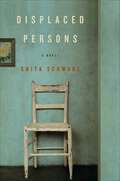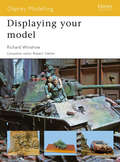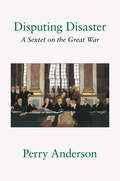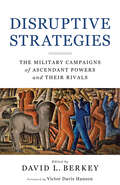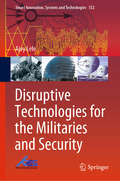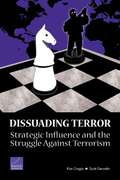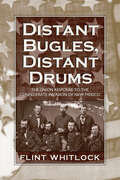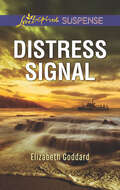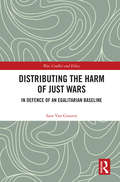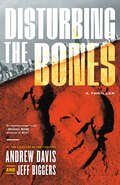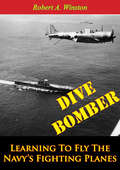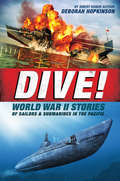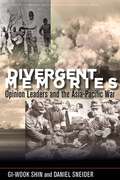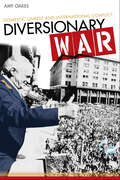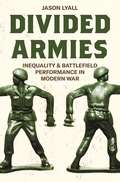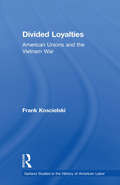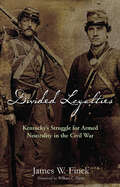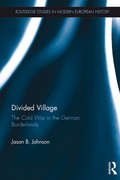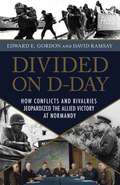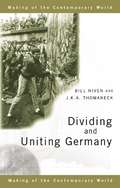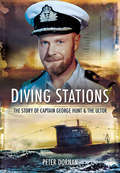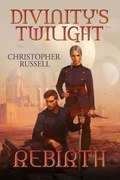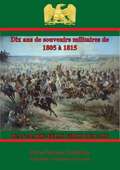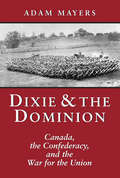- Table View
- List View
Displaced Persons: A Novel
by Ghita Schwarz“This is an amazing novel. The writing is piercing and clear, and the humanity of the author and her characters will inhabit my thoughts for years to come.”—Anne Roiphe, National Book Award-winning author of FruitfulAn astonishing tale of grief and anger, memory and survival, Displaced Persons marks the arrival of a supremely gifted new literary talent, Ghita Schwarz. Schwarz’s powerful story of a group of Holocaust survivors—“displaced persons”—struggling to remake their lives and cope with the stigma of their pasts in the wake of the monumental Nazi horror is beautiful, tragic, moving, and unforgettable, chronicling the lives of ordinary people who have suffered under extraordinary circumstances.
Displaying your Model
by Richard WindrowWhen a modeller finishes his creation he has to take an important decision on how to display it. Should he place it in a diorama, a simple display case, a mirrored stand, individual figure domes, a deep 'picture frame box, or possibly even a 'light box? This book covers all the various methods and techniques, and will be of great use to the entry-level modeller as well as the more experienced one. It features a series of dioramas and vignettes, along with an extensive gallery of other modellers' approaches to the subject, giving a range of skills and approaches from across the broad spectrum of international modelling. Book jacket.
Disputing Disaster: A Sextet on the Great War
by Perry AndersonA group portrait of six of the finest historians of the First World WarIn Disputing Disaster, Perry Anderson picks out from the highly charged historiography on the First World War one leading historian from each of the major powers that survived the conflagration: Fritz Fischer, famous historian of German war guilt; Pierre Renouvin, a disabled serviceman and preeminent authority on the conflict in France; Luigi Albertini, the Italian newspaper tycoon who, unique among scholars of the Great War, played a part in pitching his country into it; Paul W. Schroeder, the American expert on the system of Europe - an interstate relations and its breakdown in 1914; Keith Wilson, the one radical deviant from a patriotic consensus about Britain&’s role in the outbreak of the fighting; and, from Australia (summoned into the war as a dominion), Christopher Clark, acclaimed author of The Sleepwalkers.Disputing Disaster offers a compelling analysis of the major competing versions of the genesis of the Great War; fresh light on the political background of its leading historians; and a novel synthesis of the determining pressures that brought the conflict to pass.Perry Anderson is emeritus in History at UCLA, and an editor at New Left Review. Recent work: Different Speeds, Same Furies, a comparative study of Anthony Powell and Marcel Proust.
Disruptive Strategies: The Military Campaigns of Ascendant Powers and Their Rivals
by David L. BerkeySince ancient times, there have been military operations that attempted to produce tectonic shifts in the balance of power. In this volume, historians demonstrate how knowledge of past military operations can inform current policy discussions by analyzing conflicts between dominant states and the rising powers who seeks to contest their hegemony. What might a conflict between the United States and its main rival, China, look like in the years ahead? What factors are important for strategists to consider?Paul A. Rahe considers the rival ambitions between Sparta and Athens. Barry Strauss explores the Punic Wars fought by Carthage and Rome. Edward N. Luttwak examines a decisive military campaign between the Byzantine empire and its nemesis, the Sasanians. Peter R. Mansoor describes the emergence of Sweden as a military might under the leadership of Gustavus Adolphus. Andrew Roberts studies the expansion of French power during Napoleon's Italian campaign. Michael R. Auslin formulates a hypothetical conflict between China and the United States in the year 2025. Each of these conflicts offers important lessons about the behaviors of ascendant powers and the responses they provoke.
Disruptive Technologies for the Militaries and Security (Smart Innovation, Systems and Technologies #132)
by Ajey LeleThis book debates and discusses the present and future of Disruptive Technologies in general and military Disruptive Technologies in particular. Its primary goal is to discuss various critical and advanced elucidations on strategic technologies. The focus is less on extrapolating the future of technology in a strict sense, and more on understanding the Disruptive Technology paradigm. It is widely accepted that technology alone cannot win any military campaign or war. However, technological superiority always offers militaries an advantage. More importantly, technology also has a great deterrent value. Hence, on occasion, technology can help to avoid wars. Accordingly, it is important to effectively manage new technologies by identifying their strategic utility and role in existing military architectures and the possible contributions they could make towards improving overall military capabilities. This can also entail doctrinal changes, so as to translate these new technologies into concrete advantages.
Dissuading Terror: Strategic Influence and the Struggle Against Terrorism
by Kim Cragin Scott GerwehrCombat stress casualties are not necessarily higher in city operations than operations on other types of terrain. Commanders and NCOs need to have the skills to treat and prevent stress casualties and understand their implications for urban operations. The authors review the known precipitants of combat stress reaction, its battlefield treatment, and the preventive steps commanders can take to limit its extent and severity.
Distant Bugles, Distant Drums: The Union Response to the Confederate Invasion of New Mexico
by Flint WhitlockThe epic story of the 1,000 Colorado Union troops who fought against 3,000 Confederate troops in New Mexico during the Civil War.Drawing on previously overlooked diaries, letters, and contemporary newspaper accounts, military historian Flint Whitlock brings the Civil War in the West to life. Distant Bugles, Distant Drums details the battles of 1,000 Coloradans against 3,000 Confederate soldiers in New Mexico and offers vivid portraits of the leaders and soldiers involved, men whose strengths and flaws would shape the fate of the nation.On their way to Colorado in search of gold and silver for the Confederacy&’s dwindling coffers, Texan Confederates won a series of engagements along the Rio Grande. Hastily assembled troops that had marched to meet them from Colorado finally turned them back in an epic conflict at Gloriéta Pass.Miners, farmers, and peacetime officers turned themselves overnight into soldiers to keep the Confederacy from capturing the West&’s mines, shaping the outcome of the Civil War. Distant Bugles, Distant Drums tells their story.Southwest Book Award Winner from the Border Regional Library Association&“An important new book by Denver military historian Flint Whitlock . . . This well-written, solidly researched history of Colorado&’s Union troops is eye-opening.&” —Rocky Mountain News"This volume is Civil War military history at its very best. The research, especially in primary sources, is fresh, the interpretation is informed and concise, and the writing is skillful. Follow Whitlock&’s engagingly crafted narrative. He introduces you to the officers, soldiers, politicians, and merchants. He tells of their competence, loyalty, opportunities, and accomplishments.&” —James H. Nottage, Blue & Gray Magazine
Distant Thunders (Destroyermen, Book #4)
by Taylor AndersonIn the aftermath of the terrible battle in which the men of the destroyer Walker and their Lemurian allies repelled the savage assaults of the Grik, Lieutenant Commander Matthew Reddy is shocked by the arrival of a strange ship captained by Commodore Jenks of the Imperial Navy of New Britain--an island nation populated by the descendants of British East Indiamen swept through the rift centuries before. With the Walker undergoing much-needed repairs, Reddy knows the Grik have only been fended off, not defeated, and he will need all hands on deck to fight them off when they next attack--but Jenks's loyalties seem uncertain. As tension between the Allies and the Imperials mounts, Reddy will find that his suspicions are not misplaced--and that a greater danger than the Grik is about to be revealed.
Distress Signal: Distress Signal Mistaken Twin No Safe Place (Coldwater Bay Intrigue #3)
by Elizabeth GoddardA perilous reunion at sea sparks currents of passion—and peril—for former lovers in this pulse-pounding romance from the USA Today–bestselling author.When shipwreck archaeologist Cora Strand is attacked and the research boat she’s on explodes, her ex comes to her rescue. Years ago, Kirk Higgins forfeited her heart, and now with no memory of who attacked her, Cora must trust him with her life. But at the risk of blowing his cover, can the NCIS agent stop a killer determined to put them both in a watery grave?
Distributing the Harm of Just Wars: In Defence of an Egalitarian Baseline Approach (War, Conflict and Ethics)
by Sara Van GoozenThis book argues that the risk of harm in armed conflict should be divided equally between combatants and enemy non-combatants. International law requires that combatants in war take ‘all feasible precautions’ to minimize damage to civilian objects, injury to civilians, and incidental loss of civilian life. However, there is no clear explanation of what ‘feasible precautions’ means in this context, or what would count as sufficiently minimised incidental harm. As a result, it is difficult to judge whether a particular war or offensive actually satisfies this requirement. Just war theorists often consider it common sense that merely not intending to harm innocent civilians is not sufficient, but there is little clarity in the literature regarding what this means. One crucial question that is almost always overlooked is that of what the appropriate baseline distribution of risk should be. This book defends the Minimal Harm Requirement (MHR), which states that combatants should make an effort to reduce merely foreseen harm to enemy non-combatants to the lowest reasonable level. In order to assess which risk impositions are reasonable, and which are not, an egalitarian baseline should be adopted, suggesting that other things being equal risk of harm should be distributed equally between just combatants and unjust non-combatants. This book will be of much interest to students of just war theory, ethics, security studies and international relations.
Disturbing the Bones
by Jeff Biggers Andrew DavisA propulsive debut political thriller set in the aftermath of a global nuclear weapons crisis—from the acclaimed filmmaker of The Fugitive and an award-winning journalist . . ."A knife-edged investigation that morphs into a political thriller about a world on the brink. An ingenious page turner." —Michael MannA plot to disrupt a global peace summit in Chicago collides with a civil rights case breakthrough at a mysterious archaeological site . . . Chicago detective Randall Jenkins has not been back home to the historic Civil Rights hotspot of Cairo, Illinois since the disappearance of his mother, a well-known journalist, several decades ago. That all changes the day Dr. Molly Moore, an ambitious young archaeologist in the national spotlight for her groundbreaking high-tech discoveries, uncovers a set of strange bones at a huge 12,000-year-old site at a highway construction project. With retired military general and contractor William Alexander breathing down her neck to cover up the dig, Molly and Randall soon find themselves in the middle of a wild military conspiracy.The detective and archaeologist&’s entwined family mysteries suddenly thrust them into the central position as the only people who can ensure the safety of the ongoing Chicago global peace summit. They must take on the rogue general who views any disarmament agreement as a clear and present danger to the United States. The fate of global peace and the lives of Molly and Randall hang in the balance.
Dive Bomber: Learning To Fly The Navy’s Fighting Planes
by Lt.-Cmdr. Robert A. WinstonSeized by an urge to learn flying Robert Alexander Winston would not be put off by the high fees charged by the private firms; he decided to join the nascent Naval Air Service in 1935. In this fast paced, witty and engaging memoir he describes his time spent as a Naval Cadet in learning to fly at the NAS Pensacola. He passed his carrier qualification aboard USS Saratoga, before being assigned to Fighting Squadron 6 flying off the USS Enterprise. His four term hitch in the Navy ended in 1939 and he entered the Naval Reserve.Robert A. Winston was born in Washington, Indiana, in 1907 and graduated from Indiana University. He worked for The New York Times and The New York News for five years before starting flight training with the navy in 1935. He flew in fighting squadrons on both coasts and as an instructor at Pensacola, and he wrote about his initial aviation training in Dive Bomber, published in 1939 when Winston held the rank of lieutenant. In his second book, Aces Wild, he chronicled his experiences in Europe during 1939-40 as a test pilot accompanying a consignment of fighters destined for Finland. Back on active duty in the United States, he served as a flight instructor, then in the public relations office in Washington, D.C. After the attack on Pearl Harbor he was assigned to combat duty in the Pacific, which he recounts in Fighting Squadron, published in 1946 when Winston was a commander. At the end of the war he was serving on Admiral Nimitz's staff on Guam. From there he moved to Stockholm, where he served as the naval air attaché.
Dive! World War II Stories of Sailors & Submarines in the Pacific (Scholastic Focus): The Incredible Story Of U. S. Submarines In Wwii
by Deborah HopkinsonSibert Honor author Deborah Hopkinson paints a vivid portrait of the deadly battles that raged in the Pacific during WWII and the remarkable courage of the US submarine sailors who fought them.Dive! World War II Stories of Sailors & Submarines in the Pacific tells the incredible story of America's little known "war within a war" -- US submarine warfare during World War II. Following the attack on Pearl Harbor, the US entered World War II in December 1941 with only 44 Naval submarines -- many of them dating from the 1920s. With the Pacific battleship fleet decimated after Pearl Harbor, it was up to the feisty and heroic sailors aboard the US submarines to stop the Japanese invasion across the Pacific. Including breakouts highlighting submarine life and unsung African-American and female war heroes, award-winning author Deborah Hopkinson uses first-person accounts, archival materials, official Naval documents, and photographs to bring the voices and exploits of these brave service members to life.
Divergent Memories: Opinion Leaders and the Asia-Pacific War
by Gi-Wook Shin Daniel SneiderNo nation is free from the charge that it has a less-than-complete view of the past. History is not simply about recording past events--it is often contested, negotiated, and reshaped over time. Debate over the history of World War II in Asia remains surprisingly intense, and Divergent Memories examines the opinions of powerful individuals to pinpoint the sources of conflict: from Japanese colonialism in Korea and atrocities in China to the American decision to use atomic weapons against Japan. Rather than labeling others' views as "distorted" or ignoring dissenting voices to create a monolithic historical account, Gi-Wook Shin and Daniel Sneider pursue a more fruitful approach: analyzing how historical memory has developed, been formulated, and even been challenged in each country. By identifying key factors responsible for these differences, Divergent Memories provides the tools for readers to both approach their own national histories with reflection and to be more understanding of others.
Diversionary War: Domestic Unrest and International Conflict
by Amy OakesThe very existence of diversionary wars is hotly contested in the press and among political scientists. Yet no book has so far tackled the key questions of whether leaders deliberately provoke conflicts abroad to distract the public from problems at home, or whether such gambles offer a more effective response to domestic discontent than appeasing opposition groups with political or economic concessions. Diversionary Waraddresses these questions by reinterpreting key historical examples of diversionary war-such as Argentina's 1982 Falklands Islands invasion and U. S. President James Buchanan's decision to send troops to Mormon Utah in 1857. It breaks new ground by demonstrating that the use of diversionary tactics is, at best, an ineffectual strategy for managing civil unrest, and draws important conclusions for policymakers-identifying several new, and sometimes counterintuitive, avenues by which embattled states can be pushed toward adopting alternative political, social, or economic strategies for managing domestic unrest.
Divided Armies: Inequality and Battlefield Performance in Modern War (Princeton Studies in International History and Politics #166)
by Jason LyallHow do armies fight and what makes them victorious on the modern battlefield? In Divided Armies, Jason Lyall challenges long-standing answers to this classic question by linking the fate of armies to their levels of inequality. Introducing the concept of military inequality, Lyall demonstrates how a state's prewar choices about the citizenship status of ethnic groups within its population determine subsequent battlefield performance. Treating certain ethnic groups as second-class citizens, either by subjecting them to state-sanctioned discrimination or, worse, violence, undermines interethnic trust, fuels grievances, and leads victimized soldiers to subvert military authorities once war begins. The higher an army's inequality, Lyall finds, the greater its rates of desertion, side-switching, casualties, and use of coercion to force soldiers to fight.In a sweeping historical investigation, Lyall draws on Project Mars, a new dataset of 250 conventional wars fought since 1800, to test this argument. Project Mars breaks with prior efforts by including overlooked non-Western wars while cataloguing new patterns of inequality and wartime conduct across hundreds of belligerents. Combining historical comparisons and statistical analysis, Lyall also marshals evidence from nine wars, ranging from the Eastern Fronts of World Wars I and II to less familiar wars in Africa and Central Asia, to illustrate inequality's effects.Sounding the alarm on the dangers of inequality for battlefield performance, Divided Armies offers important lessons about warfare over the past two centuries—and for wars still to come.
Divided Loyalties: American Unions and the Vietnam War (Garland Studies in the History of American Labor)
by Frank KoscielskiThis book explores the international leadership of the AFL-CIO, the UAW and UAW Local 600, the world's largest union local, and reveals that overall, working-class response to the Vietnam War mirrored that of the American society as a whole.
Divided Loyalties: Kentucky’s Struggle for Armed Neutrality in the Civil War
by James W. FinckOn May 16, 1861, the Kentucky state legislature passed an ordinance declaring its neutrality, which the state’s governor, Beriah Magoffin, confirmed four days later. Kentucky’s declaration and ultimate support for the Union stood at odds with the state’s social and cultural heritage. After all, Kentucky was a slave state and enjoyed deep and meaningful connections to the new Confederacy. Much of what has been written to explain this curious choice concludes Kentucky harbored strong Unionist feelings. James Finck’s freshly written and deeply researched Divided Loyalties: Kentucky’s Struggle for Armed Neutrality in the Civil War shatters this conclusion. An in-depth study of the twelve months that decided Kentucky’s fate (November 1860 – November 1861), Divided Loyalties persuasively argues that the Commonwealth did not support neutrality out of its deep Unionist’s sentiment. In fact, it was Kentucky’s equally divided loyalties that brought about its decision to remain neutral. Both Unionists and Secessionists would come to support neutrality at different times when they felt their side would lose. Along the way, Dr. Finck examines the roles of the state legislature, the governor, other leading Kentuckians, and average citizens to understand how Kentuckians felt about the prospects of war and secession, and how bloodshed could be avoided. The finely styled prose is built upon a foundation of primary sources including letters, journals, newspapers, government documents, and published reports. By focusing exclusively on one state, one issue, and one year, Divided Loyalties provides a level of detail that will deeply interest both Kentuckians and Civil War enthusiasts alike. Kentucky’s final decision was the result of intrigue and betrayal within the Commonwealth while armies gathered around its borders waiting for any opportunity to invade. And it was within this heated environment that Kentuckians made the most important decision in their history.
Divided Village: The Cold War in the German Borderlands (Routledge Studies in Modern European History)
by Jason B. JohnsonIn 1983, then-US Vice President George H.W. Bush delivered a speech in London. He had just been in West Berlin and spoke about his first visit to the Berlin Wall. Bush then went on to describe another German wall he saw after Berlin: "if anything, that wall was an even greater obscenity than its eponym to the north." The story of that wall is a fascinating and valuable slice of the history of post-war Europe. That wall had gone up nearly two hundred miles southwest of Berlin at the edge of divided Germany, in the tiny, remote farming village of Mödlareuth. For nearly half the twentieth century, the Iron Curtain divided Mödlareuth in two. In this little valley surrounded by forests and fields, the villagers of Mödlareuth found themselves on the literal front-line of the Cold War. The East German state gradually militarized the border through the community while eastern villagers exhibited a range of responses to cope with their changing circumstances, reflective of the variable nature of the Cold War border through Germany: along the Iron Curtain, the size and isolation of the divided place influenced the local character of the division.
Divided on D-Day: How Conflicts and Rivalries Jeopardized the Allied Victory at Normandy
by Edward E. Gordon<p>In anticipation of the 75th anniversary of D-Day comes this fresh perspective on the Normandy invasion -- -the beginning of the end of World War II. <p>The book highlights the conflicting egos, national rivalries, and professional abilities of the principal D-Day commanders who planned and executed the OVERLORD Operation and its aftermath. <p>Two historians, one American and one British, show how lack of cooperation and bad decisions lengthened the war, increased casualties, and allowed the later Soviet domination of Eastern Europe. <p>From their in-depth analysis of past D-Day literature, primary and archival sources, the authors provide insightful answers to the many controversies that have long surrounded the OVERLORD campaign. Among the questions addressed are: What caused the two-month delay for the Allied breakout from the Normandy beachhead. Why did the bulk of the German army escape from the Falaise Pocket? Who stopped Patton's August 1944 advance into Germany? and Why did it take so long to open the Port of Antwerp needed for securing the required supplies for the Allied advance into Germany? <p>The evidence presented in this book makes it clear that the problems raised by these questions and many other difficulties could have been avoided if the Allied commanders had been less contentious, a factor that sometimes led to catastrophic battlefield outcomes. <p>Complete with maps that illustrate the campaign's progression and photographs of the commanders and the forbidding battlefield terrain, this new examination of the war in Europe makes a major contribution to our understanding of the decision-making behind these pivotal historic events.</p>
Dividing and Uniting Germany (The Making of the Contemporary World)
by Bill Niven J. K. ThomaneckA concise introduction to the process which led to the division of Germany in 1949, and its unification in 1990, this book also explores the economic, social and cultural divisions between and east and west, which still exist in post-unification Germany. Dividing and Uniting Germany covers all important aspects of the subject including: the role of the allies in the post-war division of the country the integration of West and East Germany into their respective blocs the problems of integrating east and west after 1990 Germany's Nazi and socialist past.
Diving Stations: The Story of Captain George Hunt and the Ultor
by Peter DornanDiving Stations is the inspiring story of Captain George Hunts career. Born in Uganda and then educated in Glasgow, he was determined to join the Navy and at 13 years old he entered HMS Conway.His prewar years saw him serving worldwide. In 1939, on the outbreak of war he was already serving in submarines. Over the next six years he was rammed twice, sunk once and had hundred of depth charges dropped around him. He gave more than he got! While in command of the Unity Class Submarine Ultor—mainly in the Mediterranean—he and his crew accounted for an astonishing 20 enemy vessels sunk by torpedo and 8 by gunfire as well as damaging another 4 ships. His fifteenth mission was described by the Admiralty as unsurpassed in the Annals of the Mediterranean Submarine Flotilla.After the War George continued his distinguished naval career becoming Senior Naval Officer West Indies (SNOWI). He emigrated to Australia where he lives today.
Divinity's Twilight: Rebirth
by Christopher Russell“Russell’s new high fantasy series launch is well written with a definite steampunk vibe and sword-and-sorcery appeal.” —Library JournalA world consumed by war. An ancient evil resurrected. A millennia-old bargain comes due . . .When two blades clash, the third will fall, and the fate of all will be jeopardized. To save Lozaria, the failures of the past must be atoned for by a new generation of heroes. The time has come for mortals to cast off sight and, in doing so, truly come to see . . .Victory is never absolute.Seven centuries ago, the forces of order won the Illyriite War on the plains of Har’muth. Darmatus and Rabban Aurelian slew their elder brother, Sarcon, the despotic architect of the conflict, then sacrificed themselves to banish the cataclysmic vortex opened with his dying breath. The first advent of the Oblivion Well was thwarted. Even without their vanished gods, the seven races of Lozaria proved themselves capable of safeguarding their world.Or so the story goes.The year is now 697 A.B.H. (After the Battle of Har’muth). Though war itself remains much the same, the weapons with which it is waged have evolved. Airships bearing powerful cannons ply the skies, reducing the influence of mages and their spells. Long-range communication has brought far-flung regions of Lozaria closer than ever before. At the center of this technological revolution are the three Terran states of Darmatia, Rabban, and Sarconia, who have fought a near ceaseless campaign of seven hundred years in an attempt to best each other. The roots of their enmity lie buried beneath the wasteland of Har’muth, a place all three nations consider best forgotten.However, an ancient power sealed within Har’muth has not forgotten them, and the descendants of those who fought on that field must now take a stand to rectify the mistakes of the past . . .
Dix ans de souvenirs militaires de 1805 à 1815
by Général Jean-Marie-Félix Girod De l'Ain« GIROD DE L'AIN (Jean-Marie-Félix), 1789-1874.Dix ans de souvenirs militaires de 1805 à 1815. Paris, Dumaine, 1873, in-8°,412 p.Nombreuses anecdotes sur l'Ecole militaire de Fontainebleau, la campagne de Prusse, l'Espagne (blocus de Cadix, mort du général Sénarmont, la campagne de Russie.» p 73 - Professeur Jean Tulard, Bibliographie Critique Des Mémoires Sur Le Consulat Et L'Empire, Droz, Genève, 1971
Dixie & the Dominion: Canada, the Confederacy, and the War for the Union
by Adam MayersDixie & the Dominion is a compelling look at how the U.S. Civil War was a shared experience that shaped the futures of both Canada and the United States. The book focuses on the last year of the war, between April of 1864 and 1865. During that 12-month period, the Confederate States sent spies and saboteurs to Canada on a secret mission. These agents struck fear along the frontier and threatened to draw Canada and Great Britain into the war.During that same time, Canadians were making their own important decisions. Chief among them was the partnership between Liberal reformer George Brown and Conservative chieftain John A. Macdonald. Their unlikely coalition was the force that would create the Dominion of Canada in 1867, and it was the pressure of the war - with its threat to the colonies’ security - that was a driving force behind this extraordinary pact.
